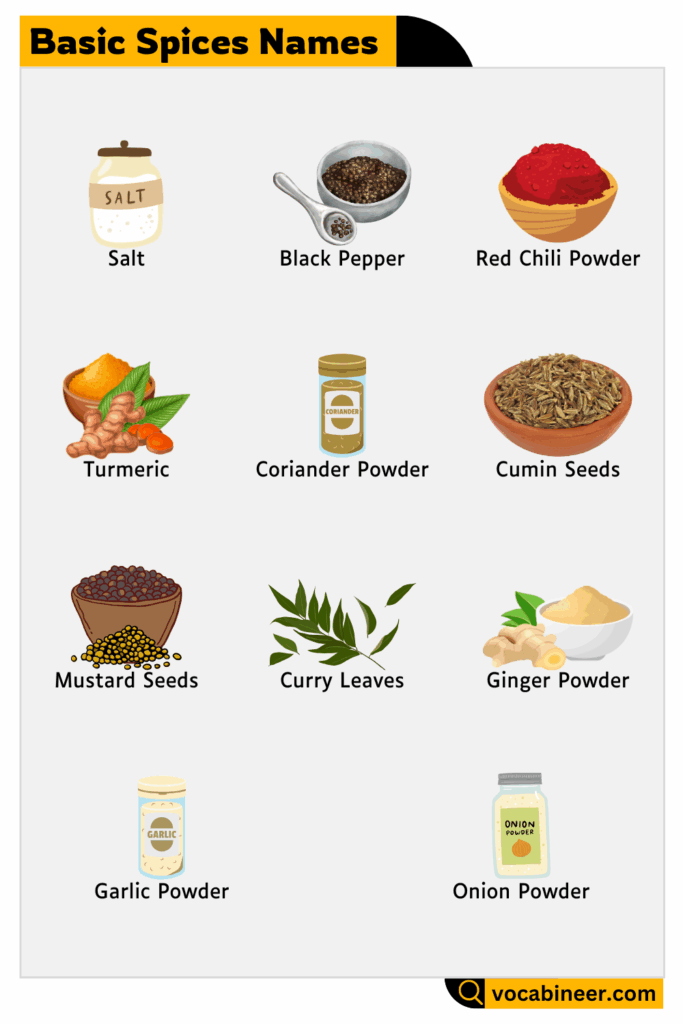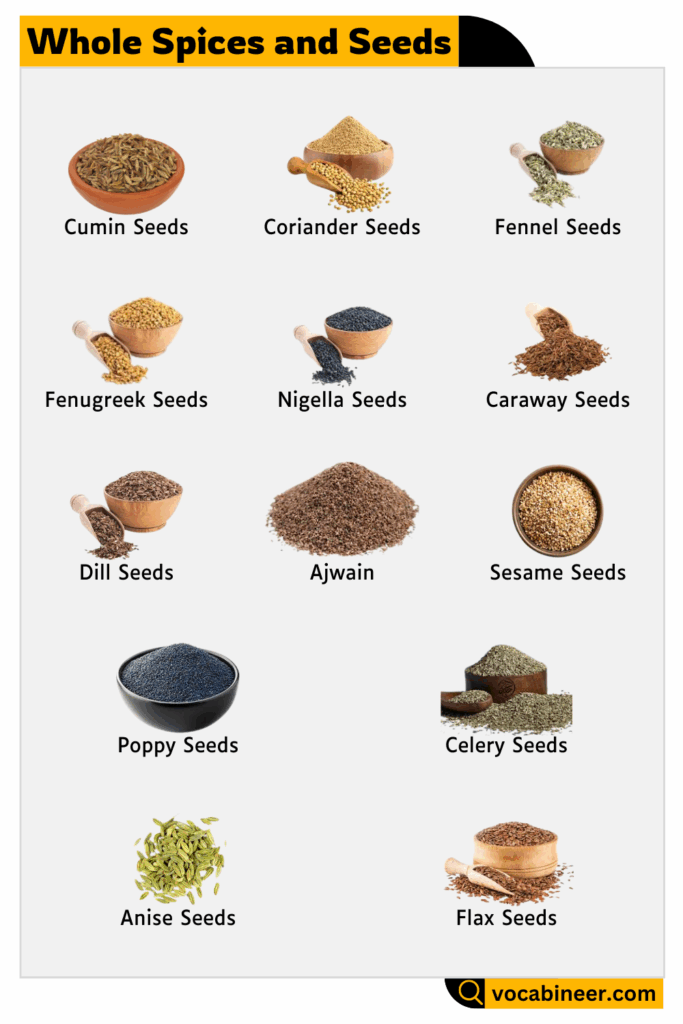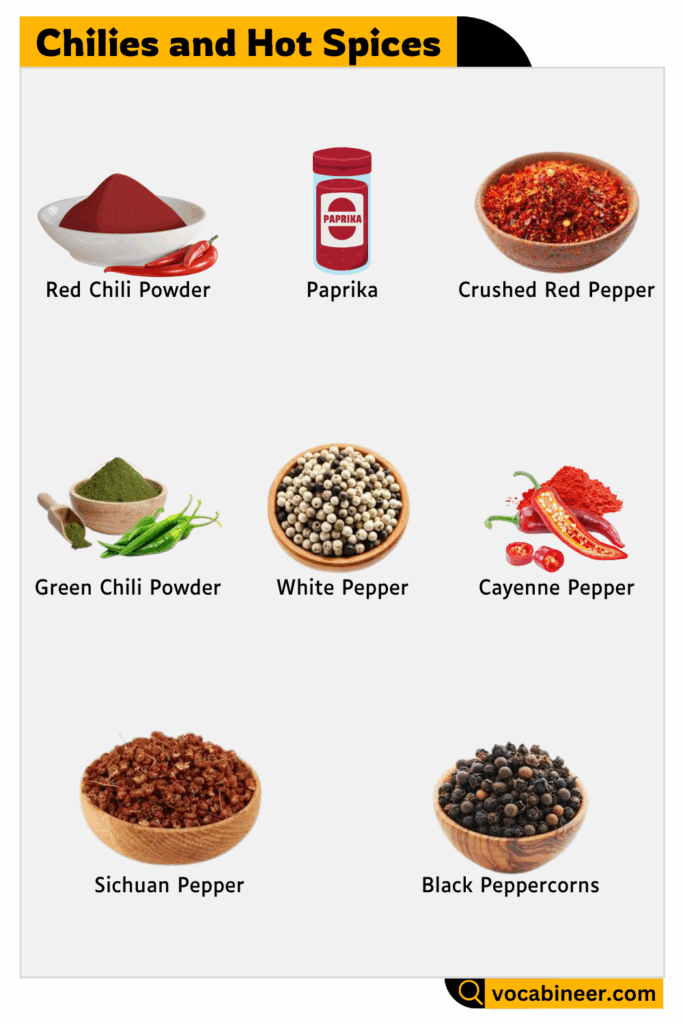Spices are natural substances taken from seeds, roots, bark, fruits, or flowers of plants that add flavor, aroma, and sometimes color to food. Understanding spices names in English along with their meanings and uses is essential for improving cooking skills and food knowledge. This complete list is designed to help learners and cooks master common culinary spices, related herbs, and seasoning terms, providing clear, concise information for both beginners and advanced learners.
In This Page
List of Spices Names in English and their Uses
Below is a detailed list of common spices names in English with their culinary and health uses. This helps learners understand each spice’s flavor, purpose, and benefits.
- Black Pepper — Adds heat and sharpness to dishes; aids digestion and improves metabolism.
- Cumin — Offers a warm, earthy flavor; supports digestion and reduces inflammation.
- Coriander — Mild, citrusy taste; helps with digestion and detoxification.
- Turmeric — Bright yellow spice with a bitter, warm flavor; known for anti-inflammatory and antioxidant properties.
- Ginger — Spicy, zesty root; eases nausea, improves digestion, and reduces inflammation.
- Cloves — Strong, sweet, and pungent; used for pain relief and oral health.
- Cardamom — Sweet and aromatic; aids digestion and freshens breath.
- Cinnamon — Sweet and woody; helps regulate blood sugar and has antioxidant effects.
- Nutmeg — Warm, sweet flavor; used for digestion and pain relief.
- Fenugreek — Bitter, nutty flavor; supports blood sugar control and digestion.
- Mustard Seeds — Pungent and sharp; used to stimulate appetite and digestion.
- Chili Powder — Hot and spicy; boosts metabolism and adds heat to dishes.
- Saffron — Delicate and floral; used for flavor, color, and mood enhancement.
- Fennel Seeds — Sweet and licorice-like; aids digestion and reduces bloating.
- Bay Leaves — Herbal and slightly floral; used to flavor soups and stews, aids digestion.
- Allspice — Combination of cinnamon, nutmeg, and cloves flavor; used in savory and sweet dishes.
- Caraway Seeds — Earthy and nutty; used for digestive health and flavoring breads.
- Star Anise — Sweet and licorice-like; used for flavor and respiratory health.
- Sumac — Tangy and citrusy; used in Middle Eastern dishes for flavor and antioxidants.
- Mace — Warm and spicy, similar to nutmeg; used in baking and sauces.
- Black Cardamom — Smoky and bold; adds depth to meat dishes and stews.
- Anise Seeds — Sweet and licorice-flavored; aids digestion and used in desserts.
- Ajwain — Strong, thyme-like flavor; helps relieve indigestion and gas.
- Asafoetida (Hing) — Pungent and sulfurous; used to improve digestion and reduce gas.
- White Pepper — Milder than black pepper; used in light-colored dishes for flavor.
- Celery Seeds — Earthy and bitter; used in salads and for digestive aid.
- Szechuan Pepper — Unique citrusy and numbing flavor; used in Asian cuisine for spice and mouth sensation.
- Paprika — Mild to hot, smoky or sweet; adds color and flavor to dishes.
- Dill Seeds — Sweet and grassy; used for flavoring and digestive benefits.
- Curry Leaves — Aromatic and citrusy; used in Indian cooking and to improve digestion.

Different Types of Spices Names in English
Learning the names of common spices in English is useful for cooking, shopping, or improving your vocabulary. In this article, you’ll learn different types of spices, their English names, and a simple explanation for each. These are grouped into categories to help you learn easily.
Popular Bark Spices Names in English
Bark spices are harvested from the inner bark of trees and are prized for their strong aroma and taste. Common bark spices include:
- Cinnamon — Sweet and woody, widely used in desserts, drinks, and savory dishes.
- Cassia — Similar to cinnamon but stronger and more pungent, common in Asian cooking.
- Sassafras — Used for flavoring root beer and traditional dishes.
- Chinese Cinnamon — A type of cassia with a stronger, spicier flavor.
Root Spices Names in English with Uses
Root spices come from the underground part of plants and are often fresh or dried. They add warmth and depth to dishes. Key root spices are:
- Ginger — Spicy and zesty, used fresh or dried in baking, teas, and savory recipes.
- Turmeric — Bright yellow and slightly bitter, popular for color and anti-inflammatory effects.
- Horseradish — Sharp and pungent, used in sauces and condiments.
- Galangal — Similar to ginger but more citrusy, used in Southeast Asian cooking.
- Wasabi — Pungent and hot, commonly served with sushi.

Fruit Spices Names in English and Their Uses
Fruit spices come from the dried fruits or berries of plants. They are commonly ground or used whole for seasoning. Below is a list of fruit spices:
- Black Pepper — Sharp and pungent, the most widely used spice worldwide.
- Chili Pepper — Hot and spicy, adds heat to many dishes.
- Allspice — Tastes like a mix of cinnamon, nutmeg, and cloves, used in baking and meat dishes.
- Juniper Berries — Piney and resinous, used in meat curing and gin production.
- Pink Peppercorns — Sweet and fruity, used in salads and sauces.
Flower Spices Names in English with Examples
Flower spices are harvested from the buds or dried flowers of plants. They often provide intense aroma and flavor:
- Cloves — Strong, sweet, and spicy, used in baking, beverages, and meat dishes.
- Saffron — Delicate, floral, and slightly sweet, prized for coloring and flavoring rice and desserts.
- Lavender — Floral and slightly sweet, used in baking and herbal teas.
- Rose Buds — Fragrant and mildly sweet, added to desserts and drinks.
Chilies and Hot Spices Name in English with Pictures
These spices add heat, sharpness, or spiciness to your food. Use more or less depending on your taste.
- Red Chili Powder – Ground chilies, hot and colorful.
- Crushed Red Pepper – Dried flakes for texture and spice.
- Green Chili Powder – Milder, made from green chilies.
- Paprika – Mild and sweet red powder; adds nice color.
- Cayenne Pepper – Hot and sharp chili powder.
- White Pepper – Milder than black pepper, used in light sauces.
- Sichuan Pepper – Gives a numbing, tingling spice; used in Chinese cooking.
- Black Peppercorns – Whole black pepper, often crushed fresh.

Leafy and Dried Herb Spices Names
These dried leaves and herbs are added for aroma, flavor, and freshness, often sprinkled at the end.
- Kasuri Methi (Dried Fenugreek Leaves) – Aromatic, slightly bitter herb.
- Dried Mint – Cool and fresh; great for chutneys and drinks.
- Dried Coriander Leaves – Adds color and mild herbal taste.
- Dried Basil – Sweet and used in Italian foods.
- Dried Oregano – Strong flavor; used in pizza and pasta.
- Dried Thyme – Earthy and minty herb.
- Rosemary – Woody and pine-like; good for baking and roasts.
- Sage – Strong flavor, used in stuffing and sauces.
- Bay Leaf – Used whole for aroma in slow-cooked dishes.
Regional Types of Spices Names in English
Spices often vary by region, reflecting local flavors and culinary traditions. Common regional spice categories include:
- Indian Spices — Turmeric, cumin, coriander, cardamom, fenugreek.
- Middle Eastern Spices — Sumac, za’atar, saffron, cumin, coriander.
- Asian Spices — Star anise, Szechuan pepper, ginger, galangal, lemongrass.
- European Spices — Bay leaves, dill seeds, caraway, juniper berries.
FAQs About Spices Names in English
Spices are mainly classified as seed, bark, root, fruit, and flower spices based on the plant part they come from.
No, spices come from roots, seeds, bark, or fruits, while herbs are the leaves of plants.
Black pepper, cumin, cinnamon, turmeric, and chili are among the most widely used spices.
Yes, many spices like turmeric, ginger, and cloves have anti-inflammatory and antioxidant properties.
Conclusion
Spices are the heart of every cuisine. They make food delicious, aromatic, and colorful. By learning these spice names in English with simple meanings, you can understand recipes, shop for groceries confidently, and describe flavors better. Keep practicing and exploring new spices in your kitchen!
Read More




